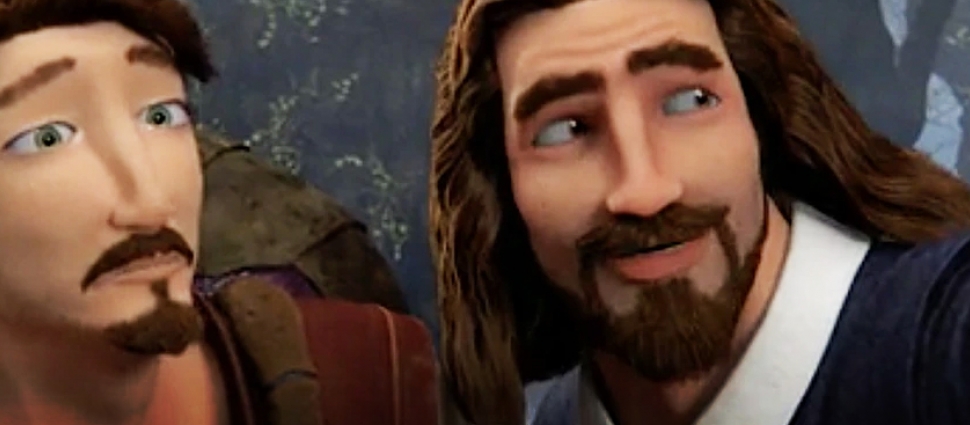Movie Review: The Pilgrim's Progress

This post takes a look at the new animated production of The Pilgrim’s Progress, produced jointly by Cat in the Mill Studio, Herald Entertainment, Revelation Media, and Vision Video. This movie cannot be ignored; it has become an instant bestseller, has spread rapidly worldwide. There are currently plans to have it translated into over a hundred languages, and it has already become the second-most watched movie on the mission field next to the Jesus movie.
To be sure, this is not the high quality animation of such studios as Pixar or Dreamworks. Yet, produced at a fraction of the cost, the animation is good enough to capture audiences accustomed to the more elaborate productions. This, and the fact that the movie modernizes the language of Bunyan (increasingly difficult for modern ears to grasp), helps to explain the growing popularity of the movie. As for the characters, I enjoyed Evangelist the most, voiced wonderfully by John Rhys Davies (Gimli and Treebeard in The Lord of the Rings).
The Gospel message of the movie adds to its growing admiration. Executive producer Steve Cleary wants to broadcast the good news in a popular medium and in an attractive manner. Didn’t Bunyan do the same in his allegory as he appeals to the “fowler” who seeks “to catch his game by divers means” (The Author’s Apology for his Book)? In this way, the movie heralds the Gospel effectively. Cleary also knows that while a “message” movie might communicate in an appealing way, it will not appeal to everyone. Many want the entertainment without the message, especially when it's this message.
So, does the animation carry the message faithful to Bunyan? In general, yes. The film includes most of the main scenes from the book, with the journey from the City of Destruction to the Celestial City depicting conversion and the Christian pilgrimage to glory. With that said, I was disappointed at times.
Before commenting more, I confess (at the risk of sounding snobbish) that I’m not a big fan of movie adaptations taking undue liberty with an author’s original work and intentions, especially when they are misrepresented. For example, Disney’s three Chronicles of Narnia movies (2005-2010), while very entertaining and not without merit, so easily strayed from C.S. Lewis that they left me longing for the low-budget yet faithful BBC television-serial (1988-1990) with all of its rudimentary cinematography and special effects.
Of course, the ones who read the books first (and can remember the details!) tend to be the most frustrated with movie versions. Maybe that’s why I enjoyed The Lord of the Rings movies (2001-2003) so much, as I couldn’t remember enough of the discrepancies from the Tolkien trilogy I read 20 years earlier in high school. This common tendency helps account for the current movie’s popularity. Less and less people today, even in the church, have actually read The Pilgrim’s Progress and have little to nothing to compare the movie to.
This animated version at times does depart from Bunyan, though not as much as the 1978 Pilgrim’s Progress movie starring Liam Neeson in his debut film role as Evangelist, and . . . Help, Goodwill, Knowledge the Shepherd, and even Christ on the cross! Interestingly, the animated version seems to follow this movie’s tendency for Apollyon to be transformed into different enemies with the Supervisor demon doing the same. Apparently, it was not enough to have Christian encounter real humans under the influence of the evil one as Bunyan did.
In any event, let’s consider some areas of departure. First, some things get left out. Characters such as the following from the allegory you will not find: Simple, Sloth, and Presumption; Formalist and Hypocrisy; Mistrust and Timorous; the four shepherds (Knowledge, Experience, Watchful, and Sincere) at the Delectable Mountains, and Atheist. Likewise, you will find no Hill Difficulty,Valley of the Shadow of Death, or Enchanted Ground. I realize that a two-hour movie can’t cover everything. Yet, considering that the 35-minute 1978 cartoon version produced by Baptista (edited from a longer 1950 version that I have yet to see) includes all of these, it’s hard to give a pass for these exclusions (By the way, if you want an animation faithful to Bunyan, get this one. It is low-quality outdated animation, but comes straight out of the allegory).
Second, and in connection with the exclusions, the movie embellishes many details which, while entertaining, are unneccesary. For example, it starts way too slowly with all sorts of extra characters and scenes and with too much time lingering in the City of Destruction before the journey begins for “Christian Pilgrim” (never referred to as Graceless as in the book). The introduction includes various demons (most notably the Supervisor) and Apollyon himself who appear on several occasions, though the latter only emerges once in the book and the former not at all. One embellishment is the too-clever renaming of the City of Destruction with the backwards “Noit Curtsed” refashioned as “Not Cursed” by a demon named Lux.
Third, and most troubling (and in connection with the embellishments), are the changes and/or misinterpretations of characters and scenes from the allegory. For example, near the wicket gate (representing faith in Christ), Christian gets pursued by flying demon-dragons (an embellishment) not just to the gate but beyond. In the allegory, Goodwill tugs Christian through the gate to avoid the arrows from the Castle of Beelzebub seeking to kill people prior to faith in Christ. Once in him, the arrows are meaningless. This fact seems to be lost in the animation’s dragons who soar over the gate wall in pursuit of Christian and are fought off by Goodwill.
Then, at the Interpreter’s house, the images covered misinterpret Bunyan, which begins with the change of Mr. Interpreter into a woman (albeit voiced elegantly by musician Kristyn Getty), when the allegory depicts a seventeenth-century pastor (an office limited to men for Bunyan), directing young Christians in spiritual matters. The episode of Passion and Patience seems at first to get the idea of waiting for one’s good things in the life to come. Yet, the later ‘Patience Path’ (an embellishment) near the cross incorrectly applies Patience to waiting to lose one’s burden of sin. The man in the iron cage crying, “No hope” (sadly with no explanation), is improperly linked with the cage later in Doubting Castle. In the allegory, the first cage indicates a professing yet not genuine believer given over to lusts and so apostacy (with no hope of release), while the latter denotes a true Christian’s loss of assurance due to spiritual declension.
Then, at the Delectable (Delightful) Mountains, the four shepherds symbolizing pastors as spiritual guides are exchanged with the Good Shepherd, Jesus, who is revealed later in the Celestial City in the movie. This is more than just a replacement; it misses the warnings of the shepherds who, in the allegory, show Christian the ongoing dangers of life and profession through the Mounts of Error and Caution and the Byway to hell.
In summary, I rejoice in the producers’ endeavor to share the gospel through this animated version and the success it has received. Still, in many respects, the movie does not remain true to Bunyan. Indeed, watch it and use it with others, but do so ready to explain the scenes and the discrepancies that occur. With this in mind, read the allegory if you have not already. May the animation spark a renewal of interest to read Bunyan’s classic work.
Bob McKelvey (@mckelvrj) is an OPC minister and serves as the Director of Research and Dean of Students at the Greystone Theological Institute. He is the author of Histories that Mansoul and Her Wars Anatomize: The Drama of Redemption in John Bunyan’s Holy War and a contributor to Drawn into Controversie: Reformed Theological Diversity and Debates within Seventeenth-Century British Puritanism. In connection with his Bunyan studies, he has written an allegory of his own, one for children: Nutonius of Acornshire.
Related Links:
- A Dangerous Journey: A Vision for the Christian Life [ Audio Disc |Download ]
- Sanctification: God's Work, Our Response [ Audio Disc | MP3 Disc | Download ]
- Bite-Size Bunyan, a series by Bob McKelvey





